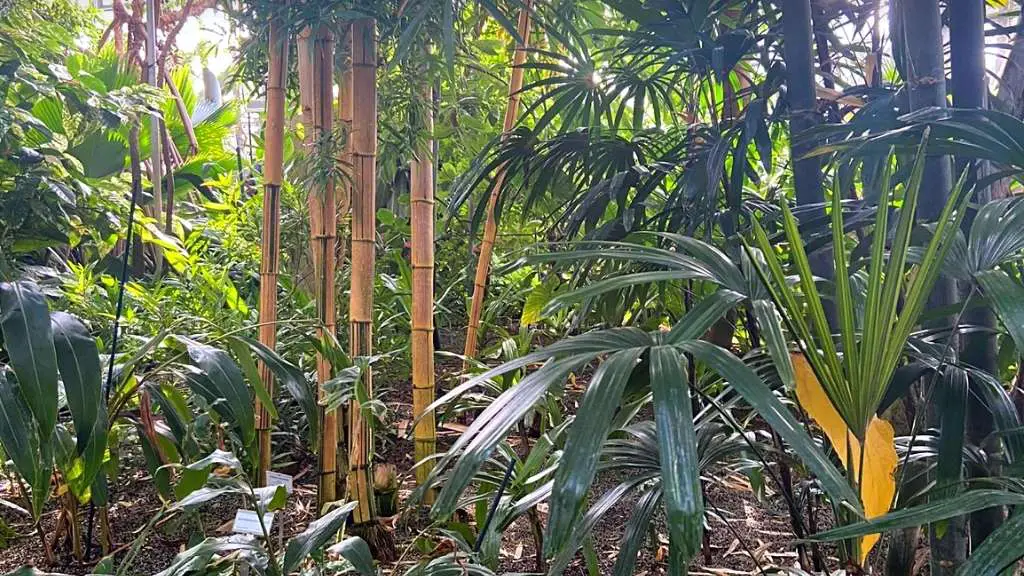Bamboo comprises an astonishing family of flowering grasses with nearly 2,000 species and cultivars in total. Some timber bamboo varieties are enormous, over 100 feet tall and a foot in diameter. Other dwarf and ground cover species thrive under the lower canopy of the forest and scarcely grow the size of a pencil. And with such a vast array of bamboos to learn about it, you could literally spend a lifetime getting to know them all. So if you’re a curious gardener, or just new to bamboo, you might begin by asking about the most common species of bamboo.
Phyllostachys aurea, or Golden Bamboo, is possibly the most common species of ornamental bamboo. It thrives in a variety of climates, does well in containers, and even withstands neglect. Bambusa vulgaris, whose name actually translates to “common bamboo,” is another widespread species. It probably originated in southern China, but has since naturalized in tropical and subtropical regions throughout the world, from the South Pacific to Latin America and sub-Saharan Africa. In terms of commercial cultivation, Moso (Phyllostachys edulis) is surely the most common bamboo species in China, while Dendrocalamus asper is more widely grown in the tropics.
In the following article, we’ll take a closer look at some of these common bamboo varieties. We’ll go over their defining characteristics so that you can recognize and identify them more easily. And equally important, you’ll be able to make an educated decision as to whether or not you’d like to have any of these common bamboo species growing in your own garden.
Bambusa vulgaris, aka Common Bamboo
Bambusa is a very diverse genus of bamboo, with about 150 species. As the name suggests, Bambusa is a common and important genus. These species are predominantly native to China and Southeast Asia. They come in a variety of shapes and sizes, but most species of Bambusa get quite large with lots of lateral branching. In the classification of bamboo, one of the most important features is whether they have a running or a clumping root system. All members of the Bambusa genus are clumpers.
Based on its botanical name (or binomial nomenclature), we know that Bambusa vulgaris must be one of the most common types of bamboo. You can find it growing all over the world, not just in Asia, but also in Africa, Central America and South America. It is fairly easy to recognize. It is one of the more towering species of bamboo, often reaching more than 50 or 60 feet in height, with dark green culms 3 to 5 inches in diameter. It has an open clumping habit, so it can spread relatively quickly, even though it’s not a runner.

In its native regions, China and Southern Asia, this species of bamboo is very important for its giant culms which are widely used for building and construction, including houses, scaffolding, and fencing. Higher levels of lignin and cellulose also make this a desirable bamboo for paper pulp. The shoots can be eaten, but they are not considered to be very tasty, compared to species like Moso, Asper and Oldhamii (see below).
B. vulgaris grows naturally in tropical climates, preferring warm, moist conditions. So it thrives in places like Vietnam and Indonesia, as well as Guatemala and Nigeria. But it’s not an ideal species or a popular ornamental in North America. It’s cold hardy down to freezing, but it won’t tolerate temperatures much below 30º F. You’ll have the best success with this species in places like Florida or Southern California, but you can do even better with a variety like Oldham’s.
B. vulgaris ‘Vittata’, a colorful cultivar of the species, is far more popular as an ornamental specimen. The distinctive culms stripes, which are each unique, have earned it the nickname “Painted Bamboo.” See our article on Striped Bamboo to learn more.
Bambusa oldhammi
Oldham’s, as it’s often known, is quite possibly the most popular ornamental species of bamboo in North America. Like all varieties of Bambusa, it’s a clumping type of bamboo native to tropical and subtropical regions. But compared to B. vulgaris, it stays rather more contained in its clump and is somewhat more cold-hardy.
Another common name for this species is simply “Chinese timber.” Indeed, it’s one of the largest types of bamboo that you can grow easily in a North American garden. In warmer climates, it can get 50 to 60 feet tall, and further north it will grow to 20 or 30 feet. Oldham’s reaches maturity in about 5 or 6 years, and that’s when it will start producing those full-sized culms; in the first couple years the culms may only be half as tall. It’s cold hardy down to about 20º F, so you can grow it in a wider range of climate zones than other tropical varieties.
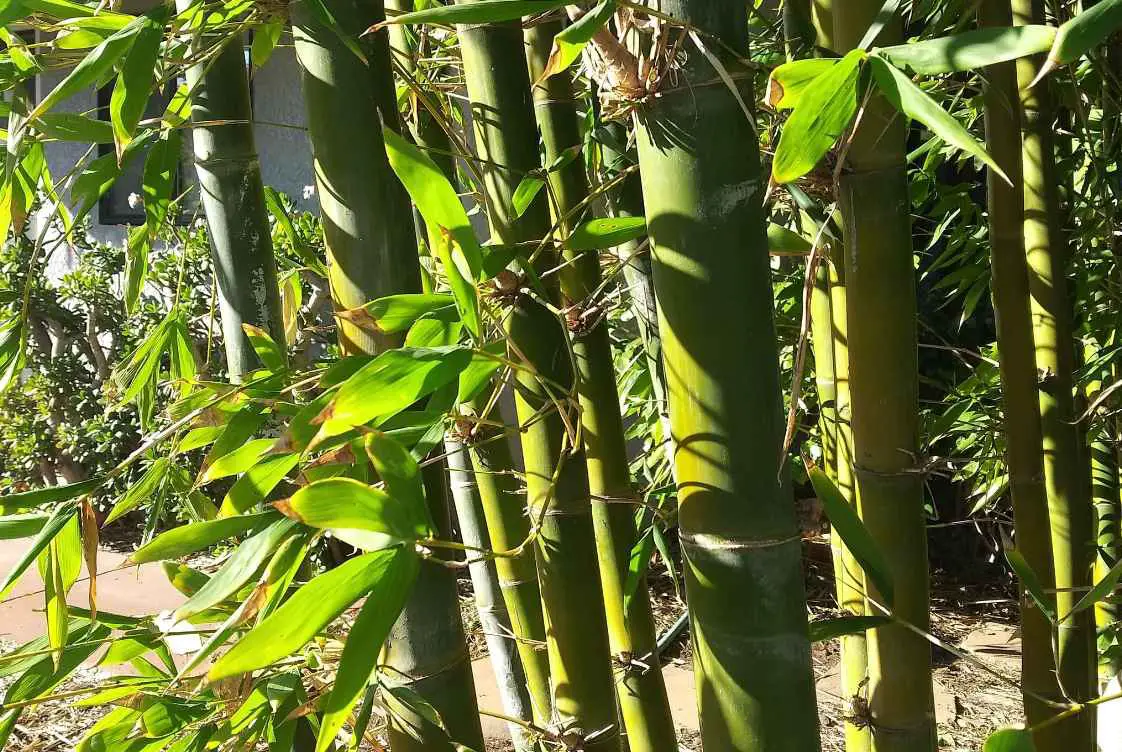
The combination of its restricted, clumping growth habit and its majestic stature, makes oldhamii a very popular choice among gardeners. It can provide an attractive centerpiece in a spacious garden, and a row of plants can make a very effective privacy screen. The impressive canes of this bamboo are also quite useful for any number of building projects, from fishing poles and garden stakes to furniture and tipi structures.
Oldhamii is one of the few speceis that is respected both as an ornamental and a commerical bamboo variety.
Phyllostachys aurea, Golden bamboo
Along with Bambusa, Phyllostachys is another of the most prevalent genera of bamboo. They are especially resilient and cold-hardy. But the several dozen varieties of this genus are all runners, and some of them can become pretty intrusive, so watch out. One thing about running bamboo is that it’s very easy to propagate because it spreads so quickly. In fact, its aggressive growth often requires you to remove significant portions of the root mass. And those portions can easily provide new plants. All this allows nurseries to propagate the plants steadily, and sell them at a pretty low price.
Indeed, Phyllostachys plants have a keen ability to proliferate. I’d like to point out, however, that the fear of bamboo taking over the world is unfounded. Yes, running bamboo can take over your yard, and maybe even your neighbor’s yard (if you’re not careful). But running bamboo has been growing for thousands of years, and if it were going to overrun the planet, it would have surely done so by now.
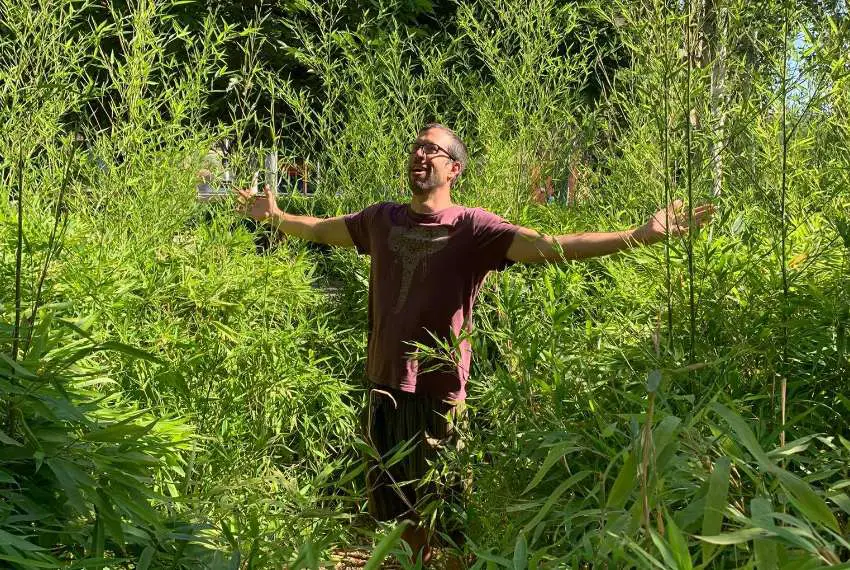
One of the most common Phyllostachys species of all is Golden bamboo, or Phyllostachys aurea, which you can find almost anywhere. People like to grow it as a privacy hedge or in big barrels in front of Asian restaurants, because it grows quickly, with dense, delicate foliage, and modest size. It grows all over the country, and all over the world.
When someone plants a bamboo screen along their fence line, they usually want it to fill in quickly, and Golden bamboo does the job nicely. It can grow to a maximum height of about 30 feet with culms 2 inches thick, but that’s under ideal conditions. In California and colder climates, it generally gets about half that tall, but your results may vary. (2022 Update: A grower in southern Alabama recently sent us a photo of their Phyllostachys aurea, about 40′ tall and 3 inches thick. I had no idea it could get that big, but it evidently loves the heat and humidity.)
Phyllostachys are also popular and common because of their cold hardiness. P. aurea is hardy down to about 0º F, making it viable in USDA zones 6-10. Not only that, but it’s also fairly drought-tolerant. In short, Golden Bamboo is virtually indestructible. No wonder you see it growing everywhere. But if indestructibility intimidates you, then you may wish to steer clear of this one.
You can recognize and identify Phyllostachys pretty easily by their distinctive sulcus groove. This is the narrow indentation that runs the length of each culm internode, on alternative sides of the bamboo stem. If you can see or feel this groove, then you know you have a running bamboo on your hands, and almost certainly a member of the genus Phyllostachys.
Phyllostachys nigra, Black bamboo
A close relative to Golden bamboo, Black bamboo shares many characteristics. It’s comparably cold-hardy and pretty similar in size. But the uncommonly dark brown or nearly black culms of this species make it especially popular for growers. Leaves are a nice deep shade of green, and so are the fresh and young shoots. But within a year or two, you’ll start to see them turning that dark, rich color that has earned this species its name.
The contrast of the green leaves and the black culms makes this variety very attractive and therefore quite popular. The poles, once harvested and dried, are excellent for light building, arts, and crafts. Use them for decoration alongside yellow bamboo for an especially pleasing effect.
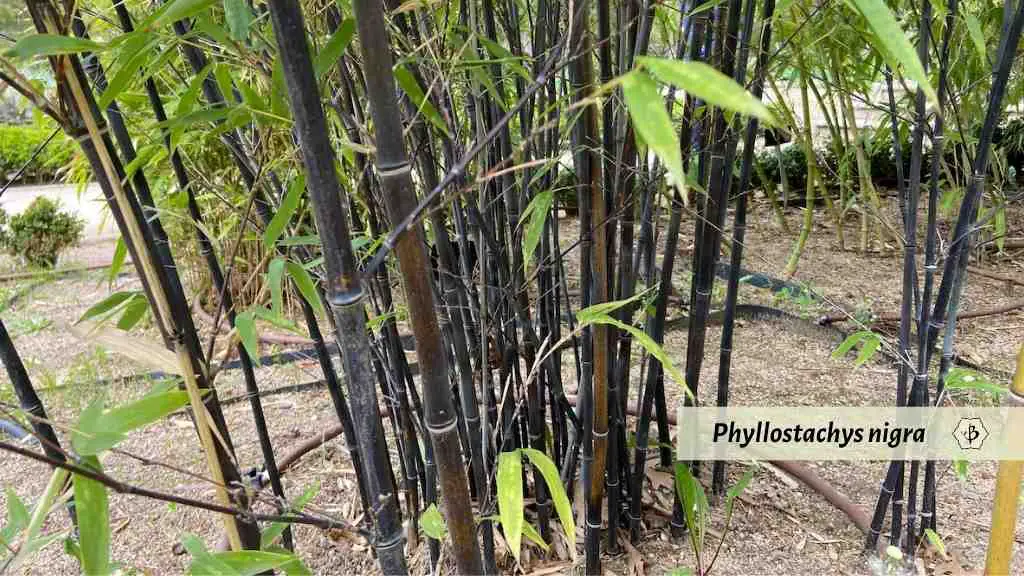
If you’re worried about the aggressive growth habit of this popular variety, try planting it in the shade. This will not affect the color of the culms, but it will slow the growth way down so that it behaves almost like a clumping bamboo. In any case, it’s always advisable to use some kind of Root Barrier when you plant a running bamboo.
Common commercial bamboo
When it comes to cultivating bamboo for commercial or industrial purposes, you have a pretty different lineup of common species. It’s best to divide these by climate, that is temperate and tropical bamboo.
In temperate climates, such as the United States, Europe, most of China and Japan, running bamboo varieties like Phyllostachys grow the best. And for commercial cultivation, big timber bamboo is almost always preferable. By far the most economically important bamboo species in China is Moso, or Phyllostachys edulis. This massive grass can grow up a meter a day, reaching towering heights of more than 100 feet. It is the species used in the vast majority of bamboo products, including flooring, clothing and kitchenwares.
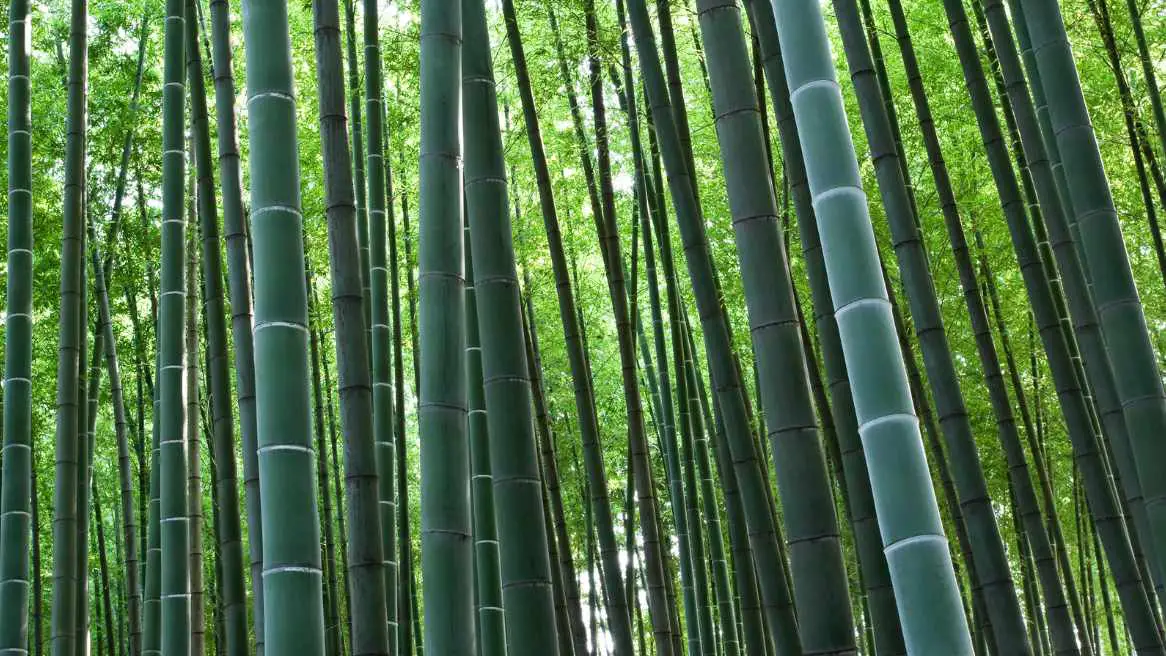
In North America, Moso doesn’t seem to do so well. Phyllostachys nigra ‘Henon”, a subspecies of Black Bamboo often called Giant Gray, is far more resilient. Especially in the southeastern part of the country, Henon is very popular for farmers interested in the up-and-coming bamboo industry. The poles are comparable in size and strength to Moso, and the shoots are edible and delicious.
In the tropical climates of Asia and Africa, Dendrocalamus asper has recently become especially popular for large-scale, commercial farming. This clumping giant produces enormous culms of extraordinary strength. Experts agree that the wood of tropical bamboo is actually stronger than temperate species like Moso. Native to Southeast Asia and Indonesia, farmers are now planting this species widely in Asia and Latin America. Although Guadua continues to be the most common and important bamboo variety in South America.
Check out our article on The best species for bamboo farming to learn more.
Branching out: More bamboo species
If you’re no longer impressed by the common varieties of bamboo named above, take a look at some of the articles from our ongoing series on bamboo species. The following list shows both the common and the scientific names of these bamboos.
- Bambusa chungii: Blue bamboo
- Bambusa malingensis: Seabreeze bamboo
- Chimonobambusa quadrangularis: Square bamboo
- Dendrocalamus strictus: Calcutta bamboo
- Hibanobambusa tranquillans: Hiroshima bamboo
- Himalayacalamus hookerianus: Himalayan blue bamboo
- Otatea acuminata: Mexican weeping bamboo
- Phyllostachys nigra ‘Henon’: Giant gray bamboo
- Pseudosasa japonica: Arrow bamboo
- Semiarundinaria fastuosa: Temple bamboo
Learn more about bamboo
If you enjoyed this article about common bamboo varieties, please consider sharing the blog post or subscribing to our mailing list. You might also be interested in some of the following links:
- Best cold-hardy bamboos for snowy climates
- Bamboo for hedges and screens
- Best bamboo varieties for poles
- Best bamboo for construction
- Growing bamboo in pots
- Growing bamboo indoors
- Bamboo containment
FEATURE PHOTO: Bambusa vulgaris, or Common bamboo, growing in the Berlin Botanical Garden. (Photo by Fred Hornaday)

